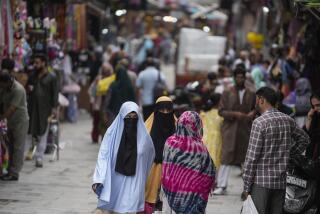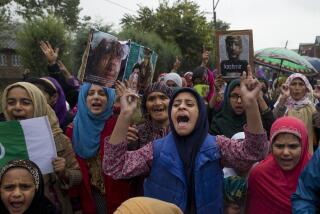India Puts Punjab Under Federal Control
- Share via
NEW DELHI — Frustrated by escalating terrorist attacks by Sikh separatists in troubled Punjab state, the Indian government late Monday dismissed the state government and imposed direct, central government control.
A terse government statement issued Monday night blamed the extreme move on a “breakdown of law and order machinery” in the important agricultural state.
The action, which gives the government of Prime Minister Rajiv Gandhi command of police and paramilitary forces stationed in Punjab, came after several weeks of increasing violence. Already this year, more than 300 people, including 15 this week, have died.
640 Killed Last Year
Last year, 640 were killed in Punjab as a result of the conflict between the government and Sikh extremists campaigning for a separate homeland for their people, who constitute the majority in the state.
Under the order, the governor of the state, Sidhartha Shankar Ray, assumes direct control over state operations, including police.
The imposition of direct central government rule--or “president’s rule” as it is termed in India’s parliamentary democracy--also has a political dimension for the Gandhi government. Although his Congress-I Party commands an overwhelming majority in the Indian Parliament, it has suffered a series of recent defeats in state elections.
A key test of the Gandhi party is set for June 17 in Haryana state. Haryana, a majority Hindu state, borders Punjab, and terrorism has already emerged as the major issue of the election.
For months, Gandhi has been under increasing pressure from Hindu constituencies to dismiss the moderate Sikh state government in Punjab that has been unable to curb the mounting violence. More than 600 million Hindus live in India compared to only 16 million Sikhs, members of a faith that combines elements of Hinduism and Islamic Sufism but which also has martial traditions.
Historically, Sikhs and Hindus have coexisted peacefully. However, a series of minor misunderstandings escalated into a serious confrontation in June, 1984, after former Indian Prime Minister Indira Gandhi ordered the Indian army to storm the Sikhs’ sacred Golden Temple in Amritsar.
In October of the same year, Indira Gandhi, mother of the current Indian prime minister, was assassinated by two Sikh members of her household security staff. In Hindu riots after the assassination several thousand Sikhs were killed, including more than 2,000 in New Delhi, the Indian capital.
The institution of president’s rule in Punjab marks a low point in Rajiv Gandhi’s attempts to bring peace to the troubled state.
After signing a peace agreement in 1985 with moderate Sikh leader Harchand Singh Longowal, who was later assassinated by Sikh extremists, Gandhi quickly moved to call state elections. The moderate Sikh government of Surjit Singh Barnala was elected.
The dismissal of Barnala, a moderate, has been a goal of Sikh extremists as the Sikh political leader blocked their ambitions for a separate homeland they call Khalistan, or “Land of the Pure.” However, Barnala had been ineffective in dealing with mounting violence and had suffered several defections from his ruling Akali Dal Party.
Even before the Sikh separatist movement emerged, Punjab has had a history of political instability. President’s rule has been imposed in the state nine times since 1953 and seven state governments have been dismissed.
Earlier Monday, the Sikh extremist said to have planned the killing of Punjab leader Longowal two years ago was shot to death by police, the Press Trust of India news agency reported. Jarnail Singh Halwara and an accomplice were killed in a shoot-out with police near Sangrur in southern Punjab, the agency said.
More to Read
Sign up for Essential California
The most important California stories and recommendations in your inbox every morning.
You may occasionally receive promotional content from the Los Angeles Times.










